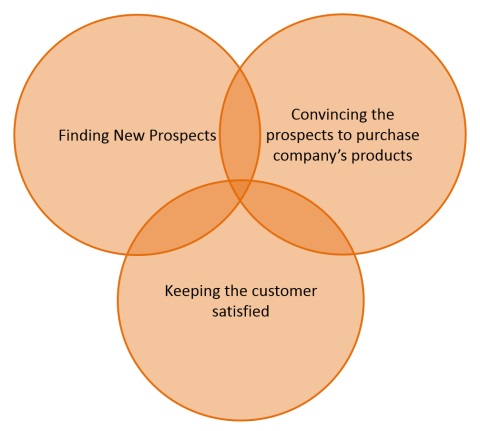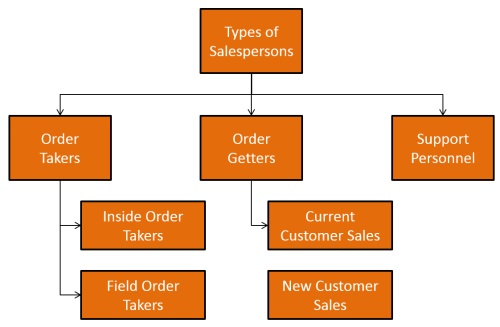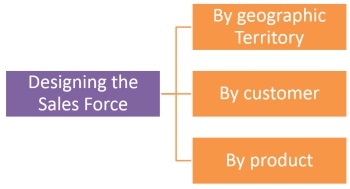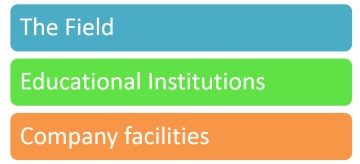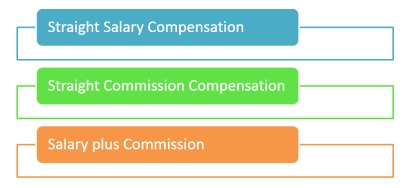Selling Process
In this chapter, you will:
- Understand the various aspects of selling process
The objective of the selling process is to enhance customer satisfaction and build a long-term relationship with the customer. The selling process differs from one salesperson to another and also varies with the selling situation. However, a typical selling process usually consists of (i) prospecting for and evaluating the potential customer (ii) preparing before approaching the potential customer, (iii) approaching the prospect, (iv) making presentations to the prospect, (v) handling the objections raised by the prospect, (vi) closing the sale and (vii) following up after the sale. Some selling situations warrant that the salesperson follows all the seven steps, whereas in some selling situations, a few of these steps can be avoided. For example, a salesperson who sells the same product to the same customer every time, be it an individual customer or a corporate customer, can avoid the prospecting and pre-approach stages. In such cases, the previous sales history provides the necessary data regarding the customer. Likewise, a long-term relationship between a salesperson and a customer allows the former to skip the prospecting and evaluating stages.
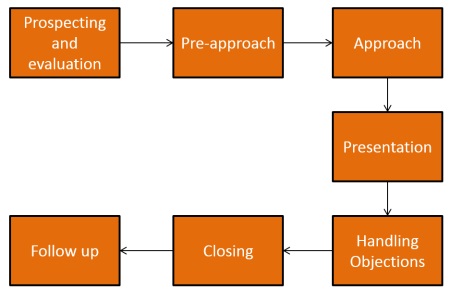
Personal Selling Approach
Prospecting and Evaluating
Prospecting is the process of finding and evaluating potential customers. For qualifying a person as a potential customer (prospect), you must identify whether the customer (individual or organization) has an immediate or a distant need to be satisfied. You must also identify if the potential customer has the willingness, ability and authority to buy the product. At this stage, you do not generally come into contact with the customer. The amount of time and effort put in in prospecting depends on the nature of the product and the marketing goals of the company.
Prospecting involves a) generating sales leads, b) identifying prospects and c) qualifying prospects.
Generating leads
A sales lead (potential prospect) can be in the form of an individual or an organization that might need or buy your company’s product. Salespersons use a variety of sources to generate leads such as:
(a) People: This category consists of your existing customers, suppliers, former customers, dealers and other salespersons of the company, or the friends, relatives, and other people in his reference group, who may lead.
(b) Events: You can come into contact with the potential at any social event, seminar, conference, trade show or exhibition.
(c) Published information: You can take the help of newspapers, telephone directories, trade directories (e.g. yellow pages), business cards, coupons, sales records, computer databases, public records, mailing lists, organization directories, etc. to identify potential sales leads. This published information usually helps in making cold calls.
(d) Associations: As salesperson, you can be a member of professional bodies (e.g. National Association of Sales Professionals, Sales & Marketing Executives International trade associations, chambers of commerce, etc. Sales leads can be generated and identified at various programs, meetings and seminars conducted by such professional bodies.
Identifying prospects
A prospect is a person or an organization that indicates a need for your product. You can identify a prospect by writing to him, or by making a phone call or through telemarketing. Salespersons make phone calls, which is also known as cold calling, in order to contact a prospect. In a cold call, a salesperson either visits or calls up people whom he does not know. The salesperson may visit a potential customer either by taking a prior appointment or without it. However, adopting the latter approach might be both costly and time consuming and also does not promise to generate a customer. Telemarketing is yet another tool to identify prospects and this utilizes the services of specialized sales people to contact potential customers over the telephone.
Qualifying prospects
After identifying a potential lead (prospect), you qualify whether the prospect can afford to make a purchase or not. It is not worthwhile to invest time and effort in all the prospects because some customers may not have the need or the financial capacity to make the purchase. There may also be some prospects who lack the authority to make the purchase decision. Therefore, it is important for the salesperson to first evaluate the capacity, willingness and authority of the prospect to make a purchase decision. To obtain this information for consumer products, the salesperson inquires the prospect about his or her occupation, place of residence, etc. If the prospect is a corporate entity, you can evaluate its credit rating and annual reports before qualifying it as a potential customer. On the basis of the information gathered from the prospect, you can qualify the prospect as a cold lead (a prospect who cannot turn into a customer), a warm lead (a prospect who has a latent need to buy the product) or a hot lead (a prospect who is willing to make the purchase).
Pre-approach
After having identified the hot leads, as salesperson, you plan and prepare for making a sales call on them. The pre-approach stage of personal selling process involves further sub-stages such as creation of the prospect’s profile, deciding on the approach, establishing the objectives of the sales call, and preparing for the presentation.
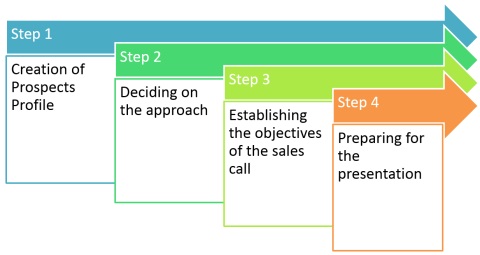
PreSales Approach
Creation of the prospect’s profile requires you to be involved in certain information-gathering activities. For developing a profile, you try to gather information about the personal characteristics of the prospect, his specific product needs, brands that are currently being used by the prospect and the prospect’s opinion of other brands. While selling to an organizational buyer, you might also need to collect information about the key decision makers in the organization. Information pertaining to the credit history of the organization, history of the particular sales account and problems associated with the account, and that of the product needs of the organization also help you develop an effective sales presentation. You can also update your knowledge by obtaining and reading relevant literature on the product. By following such a thorough approach, you can communicate better with the prospect which helps you understand the prospect’s needs better, so that you can offer a suitable product to meet those needs.
After developing the profile of the prospect, you need to decide on how to approach the prospect with your sales proposition. You can make a cold call to the prospect over the phone or in person. If the prospect is an existing customer, you can pay him an unannounced visit or take an appointment to visit the person. You can also initiate a contact with the prospect by sending him a letter.
After having decided the approach, you must establish the objectives of the sales call. You need to realize-the fact that the prospect’s time is valuable and that he would expect you to justify the time given to you for making the sales presentation. Therefore, framing of clear objectives is essential for the success of a sales call.
The last activity to be performed by you in the pre-approach stage is to prepare for the presentation. You develop your presentation on the basis of the information gathered earlier. You update yourself with relevant information, and assemble together all the material like visual aids that would be necessary to make an effective presentation.
Approach
Approach is the stage in the selling process in which you make an initial contact with the potential customer and try to find out his needs. At this stage, creating a favorable impression on the buyer is more important for you than pushing the product. An effective salesperson will utilize the approach stage to lay the foundation for a successful presentation later, by attracting the prospect’s attention, building a rapport with him and generating an interest in him for the product.
Personal characteristics of the salesperson like his appearance and his mannerisms are also important factors that affect the outcome of the sales call. For instance, a well-groomed and well-dressed salesperson will create a favorable impression on a prospective buyer unlike a shabbily dressed and unkempt person.
You may use various methods of approach. The method used depends on your choice, the personal characteristics of the prospect, the type of the product, and the resources available with the firm. The first method – referrals — involves you approaching the prospect by giving the reference of an acquaintance. The second method, cold canvassing, involves you approaching the prospect without obtaining his prior consent. The third of approach is through repeat contact and is applicable for the existing customers of the company.
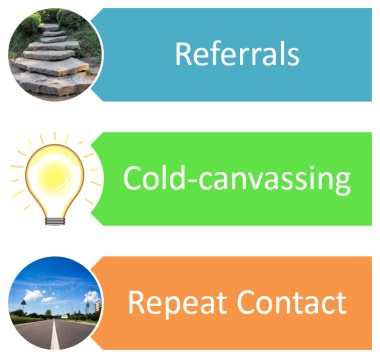
General Sales Approach
Presentation
The sales presentation is the most important step in the sales process. The aim of a sales presentation is to attract the prospect’s attention, stimulate his interest and stir a desire for the product, so that he takes appropriate action. Sales presentations are based on the AIDA (Attention, Interest, Desire and Action) concept according to which, you first attract the attention of the potential customer, create interest and stimulate a desire for the product or service, which directs the potential customer to take action to fulfill the desire. You can create interest about the product by allowing the prospect to touch, hold and examine it, while you deliver the sales talk or the presentation.
Although presentations can take many forms, their main aim is to communicate the product’s benefits effectively to the prospect and convince him to purchase the product. A good sales presentation speaks not only about the benefits the customer is looking for, but also convinces him about the additional benefits of the product.
You can use a number of approaches like the canned sales approach, formulated sales approach and need satisfaction approach to make the presentation.
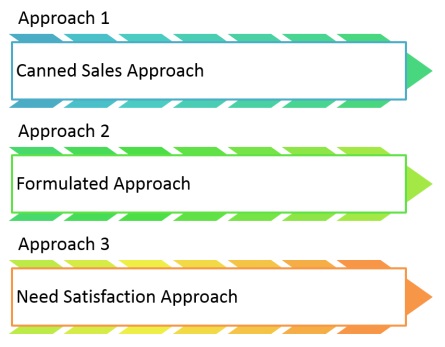
Various Sales Approaches
- Canned sales approach: In this form of presentation, you deliver a memorized sales talk. The same message is repeated / delivered to all the buyers interested in a specific product. This style of presentation is based on the stimulus-response process i.e., the buyer is passive and can be stimulated to buy the product. This approach is also known as stimulus response approach.
Canned sales approach is used when the product is not very technical and/or when the salesperson is inexperienced. It is extensively used in door-to-door selling and in telemarketing programs. The main disadvantage of this approach is that it does not give the buyer an opportunity to raise questions, which be frustrating for him.
- Formulated approach: This approach is also based on the stimulus-response process. You identify the buyer’s needs and his buying styles and then use one appeal after another, hoping to hit the right chord. In other words, you formulate the presentation in such a way that it explains and convinces the customer how the product can satisfy his needs.
- Need satisfaction approach: This approach is based on the principle that each customer has a different set of needs. You are required to identify the customer’s needs by gathering information about him. For this, you have to develop the habit of listening to the customer. You are also required to think from the buyer’s point of view and then plan your presentation accordingly. This approach calls for customizing the sales presentation to cater to the needs of individual customers. Therefore, this is better suited for experienced and sophisticated sales personnel as they are well versed with the art of communication and persuasion. The limitation of this approach is that it consumes a lot of time and requires an experienced salesperson for the presentation to be effective.
Handling Objections
As salesperson, you need to clarify any doubts or objections that the customer may have. In fact, the conspicuous absence of objections can be an indication that the customer is not interested in buying the product. An objection brings out the latent concerns of the prospective buyer and needs to be addressed. It should be viewed as a request for further information regarding certain aspects of the sale or product. An effective salesperson considers the objection as an opportunity to satisfy the customer and restrain him from switching to a competitor. Therefore, you need to probe into the objection to understand the true nature of the problem and try to solve it.
Some common reasons why prospects raise objections are:
- The prospect may not have enough time to talk to the salesperson.
- He or she may not have money and/or authority to make a purchase.
- The product may not suit the needs of the prospect.
- The prospect might not have had a good experience with the salesperson during the presentation stage.
- The prospect may raise objections to gain more information about the product.
- The prospect might raise objections out of sheer habit.
The most common type of objection is the price objection. Price may be a genuine concern for the customer, but at times, it may only be a shield for other concerns. Therefore, when you face a price objection, you need to probe further to ascertain whether the customer is objecting to the price only to conceal the other hidden concerns. Apart from the price of the product or service, other aspects on which the customer may raise objections pertain to product quality, reputation of the company, etc.
Ways to overcome objections are:
- Listening to the prospect, asking questions and responding to his objections.
- Being clear and straight forward in answering queries. The customer should not get the feeling that the salesperson is being evasive.
- Agreeing with the customer’s objection and coming up with a feasible solution to resolve the objection. This method is also known as yes-but method; it avoids contradictions and confrontations that mar the sale.
- Sometimes, the salesperson may not be sure of the answer to a customer’s query. In such a situation, the salesperson needs to reassure the customer that he will get back to him with the answer as early as possible and should keep his word.
- The salesperson should anticipate the objections that are likely to be raised by the prospect and should counter them even before the prospect can raise them. But this can be risky, as the prospect may not have considered raising such objections at all.
Closing
The stage in which you ask the potential customer to make the purchase is known as closing. In the closing stage too, customers may raise objections due to various reasons. For example, the financial position of the customer may not be good or the customer may not be mentally prepared to purchase the product. The salesperson should refrain from duping the customer into buying the product, but should try earnestly to clear the objections and then attempt to close the sale.
You can attempt to make a trial close at several points during the presentation by enquiring about the financial terms and conditions suitable to the customer, the preferred mode of delivery, etc. The response of the customer to such questions will help you know how close the customer is to placing an order.
The most popular techniques for closing a sale are:
- Silent close: The salesperson makes the presentation and waits quietly for the customer to make the purchase decision.
- Direct close: The salesperson asks directly for the close of the sale. For example, the salesperson may ask the potential customer the question - “Are you ready to place an order?”
- Assumptive close: The salesperson assumes the customer’s consent for the close. The salesperson just says “I have completed all the necessary paperwork. All you need to do is read through and sign the papers.”
- Alternative close: The salesperson seeks to close the sale by providing him different alternatives. For example, questions like “Would you prefer this color over that?” Or, “Would you like the product to be shipped?,” etc. indicate an alternative choice.
- Concession close: The salesperson can offer to give some concession to the customer and tempt him to make the purchase decision.
- Cautious close: The salesperson becomes careful in inquiring about the close. He can ask the potential customer if he would like to ask anything before closing the deal.
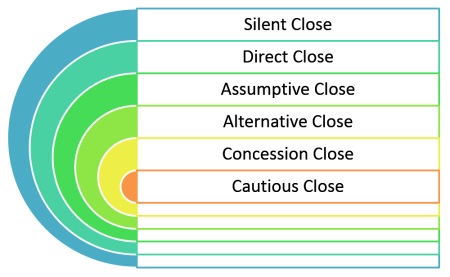
Sales Closure Methods
The salesperson must try to spend a few minutes with the customer after closing the deal as it reassures the customer that he has made a wise decision and makes him feel good. The sales person may also leave a small gift/memento with the company’s name/logo on it, or invite the customer to contact him whenever a need arises. The salesperson may seek to develop friendly relations with the customer by remembering to greet the customer on important occasions such as his birthday, the New Year, etc.
Follow up
The objective of every salesperson is to ensure repeat sales. This can be achieved by enhancing customer satisfaction. The follow up stage is the last stage in the selling process wherein you aim to develop a long-term relationship with the customer. This stage plays an important role in showing that your company and you are genuinely interested in nurturing a long-term relationship with the customer, rather than just making a sale. Follow up after closing the sale also helps reduce cognitive dissonance.
As part of the follow up, you can call upon the customer to enquire if the order was delivered in time, whether the customer faced any problem after installation, or whether the customer is satisfied with the product or not, etc. Calling on the customer after the sale also helps you determine the future needs the customer.
The follow up stage aims to accomplish four objectives. It helps your company gain customer satisfaction and prevents cognitive dissonance in the customers. It also helps to generate new referrals for you and in the long run, repurchase orders.
Summary:
- Prospecting: is the process of finding and evaluating potential customers.
- Generating Lead: A sales lead (potential prospect) can be in the form of an individual or an organization that might need or buy your company’s product.
- Identifying Prospects: A salesperson can identify prospect by writing to him, or by making a phone call or through telemarketing.
- Qualifying Prospects: helps a salesperson identify whether the prospect can afford to make a purchase or not.
- Pre-approach: involves further sub-stages such as creation of the prospect’s profile, deciding on the approach, establishing the objectives of the sales call, and preparing for the presentation.
- Approach: is the stage in the selling process in which the salesperson makes an initial contact with the potential customer and try to find out his needs.
- Presentation: The aim of a sales presentation is to attract the prospect’s attention, stimulate his interest and stir a desire for the product, so that he takes appropriate action.
- Handling Objections: An effective salesperson considers the objection as an opportunity to satisfy the customer and restrain him from switching to a competitor.
- Closing: The stage in which the salesperson asks the potential customer to make the purchase is known as closing.
- Follow-up: This stage plays an important role in showing that your company and you are genuinely interested in nurturing a long-term relationship with the customer, rather than just making a sale.
 MBA INSTITUTE™
MBA INSTITUTE™
